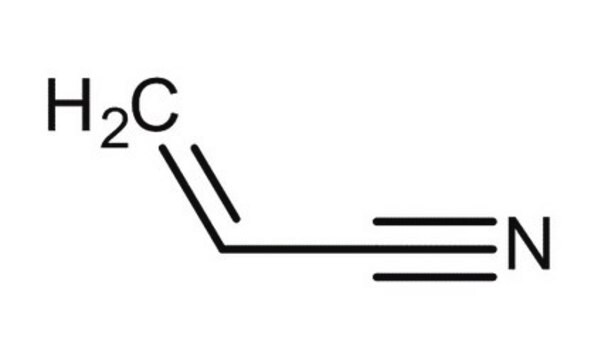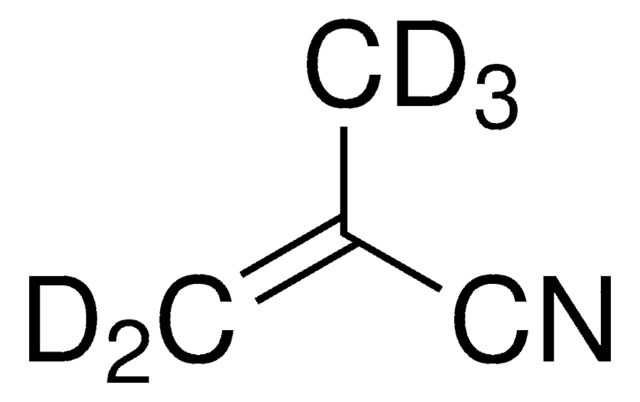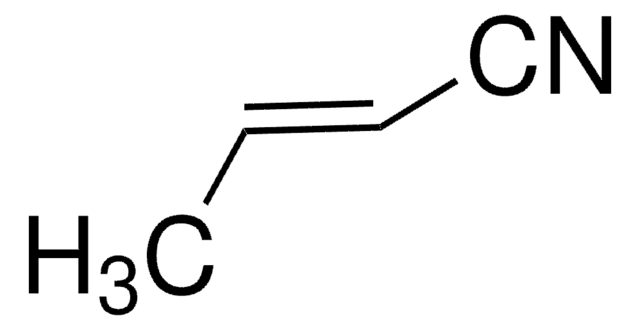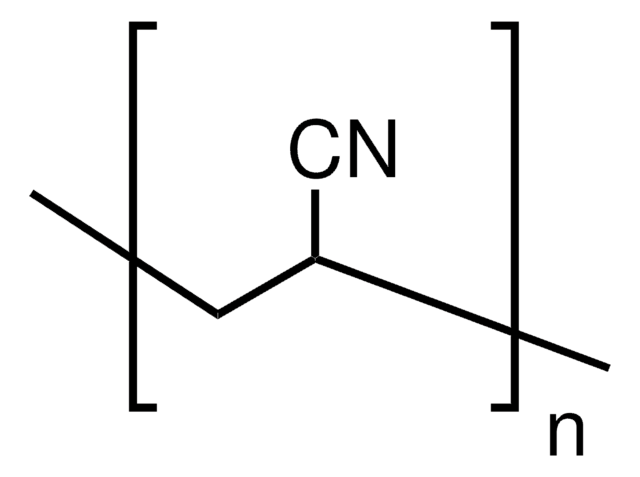110213
Acrylonitrile
≥99%, contains 35-45 ppm monomethyl ether hydroquinone as inhibitor
Sinonimo/i:
Vinyl cyanide
About This Item
Prodotti consigliati
Densità del vapore
1.83 (vs air)
Livello qualitativo
Tensione di vapore
86 mmHg ( 20 °C)
Saggio
≥99%
Temp. autoaccensione
897 °F
contiene
35-45 ppm monomethyl ether hydroquinone as inhibitor
Limite di esplosione
17 %
Indice di rifrazione
n20/D 1.391 (lit.)
P. ebollizione
77 °C (lit.)
Punto di fusione
−83 °C (lit.)
Stringa SMILE
C=CC#N
InChI
1S/C3H3N/c1-2-3-4/h2H,1H2
NLHHRLWOUZZQLW-UHFFFAOYSA-N
Cerchi prodotti simili? Visita Guida al confronto tra prodotti
Categorie correlate
Descrizione generale
Applicazioni
- In the preparation of the 3D-printed polymer material, Acrylonitrile Butadiene Styrene (ABS) which is a commonly used engineering thermoplastic known for its high strength, durability, and heat resistance. It serves as a suitable substrate for a wide range of applications, including in the medical field, compatible manufacturing processes, injection molding, blow molding, and extrusion.
- In the copolymerization with lignosulfonate to develop a carbon fiber precursor. This copolymer can serve as a precursor material that undergoes further thermal treatment to produce carbon fibers.
- To synthesize acrylamide grafted acrylonitrile copolymer membranes, which serve as a support matrix for the immobilization of cellulase enzymes.
Azioni biochim/fisiol
Avvertenze
Danger
Indicazioni di pericolo
Consigli di prudenza
Classi di pericolo
Acute Tox. 3 Dermal - Acute Tox. 3 Inhalation - Acute Tox. 3 Oral - Aquatic Chronic 2 - Carc. 1B - Eye Dam. 1 - Flam. Liq. 2 - Skin Irrit. 2 - Skin Sens. 1B - STOT SE 3
Organi bersaglio
Respiratory system
Codice della classe di stoccaggio
3 - Flammable liquids
Classe di pericolosità dell'acqua (WGK)
WGK 3
Punto d’infiammabilità (°F)
23.0 °F - closed cup
Punto d’infiammabilità (°C)
-5 °C - closed cup
Dispositivi di protezione individuale
Faceshields, Gloves, Goggles, type ABEK (EN14387) respirator filter
Elenchi normativi
Forniamo informazioni su eventuali restrizioni prevalentemente per i prodotti chimici. Per altre tipologie di prodotto siamo in grado di fornire soltanto informazioni limitate. Nessuna segnalazione significa che nessuno dei componenti è citato in un elenco. È dovere dell’utilizzatore assicurarsi che il prodotto venga impiegato in maniera sicura e a norme di legge.
EU REACH Annex XVII (Restriction List)
Scegli una delle versioni più recenti:
Possiedi già questo prodotto?
I documenti relativi ai prodotti acquistati recentemente sono disponibili nell’Archivio dei documenti.
I clienti hanno visto anche
Global Trade Item Number
| SKU | GTIN |
|---|---|
| 110213-18L | 4061837398988 |
| 110213-2L | 4061838695055 |
| 110213-500ML | 4061838695079 |
| 110213-50L | |
| 110213-100ML | 4061838695031 |
| 110213-1L | 4061838695048 |
| 110213-2.5L | |
| 110213-4L | 4061838695062 |
| 110213-4X1L | |
| 110213-5ML | 4061838695086 |
Il team dei nostri ricercatori vanta grande esperienza in tutte le aree della ricerca quali Life Science, scienza dei materiali, sintesi chimica, cromatografia, discipline analitiche, ecc..
Contatta l'Assistenza Tecnica.
















